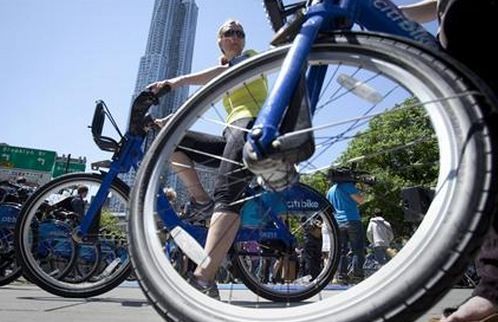Sustained Bicycle Riding Might Increase Risk of Prostate Cancer in Men
| Arthur Dominic Villasanta | | Mar 19, 2015 11:57 PM EDT |
(Photo : Reuters) Bike riders
A new study that suggests a link between serious bike riding and an increase in risk of prostate cancer has led to warnings to slow down on bike riding.
What research there is on the connection between bike riding and prostate cancer has focused on the knowledge that bike seats are the primary cause of this link. There is some evidence the trauma of bike riding for men might harm the prostate and lead to prostatitis, or the inflammation of the prostate.
Like Us on Facebook
This new study from the University College London found that men riding a bicycle more than 8.5 hours a week were more likely to have prostate cancer than others that rode less often.
This finding also had to do more with the design of bicycle seats. Some bicycle seats can put pressure on the prostate area when a man rides for long periods over time. This pressure hurts the prostate and might lead to prostatitis.
The pressure from frequent bike riding might also increase the risk for infertility and erectile dysfunction, said some studies.
The researchers that did the University College London study cautioned, however, their findings weren't definitive enough since it relied only on self-reported data.
Study lead author Dr. Milo Hollingworth said the findings were "difficult to interpret." He said the health benefits of bike riding "are much more important" than the results of the study.
A Swedish study conducted between 1998 and 2007 found that lifetime physical activity reduces the incidence of prostate cancer. This study followed 45,887 men aged 45 to 79 and concluded the risk of developing prostate cancer was reduced by seven percent with each 30 minute period of walking or bicycling a day.
Symptoms of prostatitis include frequent urination, slow or incomplete flow of urine, pain while urinating, erectile dysfunction, lower back or abdominal pain, and pain in areas near the prostate, such as the scrotum, urethra, and between the genitals and anus.
Worldwide, prostate cancer is the second most common type of cancer and the fifth leading cause of cancer-related death in men. In 2012 it occurred in 1.1 million men and caused 307,000 deaths.
It was the most common cancer in males in 84 countries, occurring more commonly in the developed world.
Symptoms of advanced prostate cancer include urinary problems, a decrease in the stream of urine, discomfort in the pelvic area, erectile dysfunction, blood in the urine or semen, and pain in the lower back, hips or thighs.
©2015 Chinatopix All rights reserved. Do not reproduce without permission
EDITOR'S PICKS
-

Did the Trump administration just announce plans for a trade war with ‘hostile’ China and Russia?
-

US Senate passes Taiwan travel bill slammed by China
-

As Yan Sihong’s family grieves, here are other Chinese students who went missing abroad. Some have never been found
-

Beijing blasts Western critics who ‘smear China’ with the term sharp power
-

China Envoy Seeks to Defuse Tensions With U.S. as a Trade War Brews
-

Singapore's Deputy PM Provides Bitcoin Vote of Confidence Amid China's Blanket Bans
-

China warns investors over risks in overseas virtual currency trading
-

Chinese government most trustworthy: survey
-

Kashima Antlers On Course For Back-To-Back Titles
MOST POPULAR
LATEST NEWS
Zhou Yongkang: China's Former Security Chief Sentenced to Life in Prison

China's former Chief of the Ministry of Public Security, Zhou Yongkang, has been given a life sentence after he was found guilty of abusing his office, bribery and deliberately ... Full Article
TRENDING STORY

China Pork Prices Expected to Stabilize As The Supplies Recover

Elephone P9000 Smartphone is now on Sale on Amazon India

There's a Big Chance Cliffhangers Won't Still Be Resolved When Grey's Anatomy Season 13 Returns

Supreme Court Ruled on Samsung vs Apple Dispute for Patent Infringement

Microsoft Surface Pro 5 Rumors and Release Date: What is the Latest?










